10 February 2006
A Commander's Stress
“Sir, there’s been an incident.” An NCO from the Tactical Operations Center (TOC) walked into the dark tent I was staying. I was laying in bed, working on the computer thinking about going to sleep. I lost track of time and was up much later than I should have been. I looked down at my watch. It was about 0130 in the morning. “What happened?” I asked. “A convoy that your guys were escorting hit an IED about 10 minutes ago. They’re calling in MedEvac now,” he said “Are any of my guys hurt?” I asked anxiously. “We don’t think so,” he replied. He said he thought it was “the other unit’s gun truck” that was hit. The problem was that there was not suppose to be another gun truck with that convoy. Only my guys were suppose to have gun trucks.
I got dressed and went to the TOC. It was business as usual there. Soldiers in the TOC were dealing with the typical late night/early morning cases of small arms fire and IEDs that were “close.” I looked at the clock, 0145. “What’s the deal with my guys, you got an update?” I asked. “They called in a MedEvac, one casualty was ‘urgent’ and one was ‘priority,’” the battle captain replied. “Was one of my guys injured?” I quickly jumped in as he was speaking. “We don’t know yet, but we don’t think so,” he replied. “We’re trying to find out,” he said.
An “urgent” casualty is one that must be evacuated within two hours or he will either lose life, limb or eyesight. A “priority” casualty is one that must be evacuated within six hours or he will lose life, limb or eyesight.
When units are far away, we typically rely on a communications system that is something like a civilian version of instant messaging. It’s not as quick or complete as the radio but it’s secure and it works well over long distances. In situations like this, it’s important to have “tactical patience” when in the back collecting information. The first priority of soldiers on the scene is to address the situation at hand. Considering where these guys were at the time, they were likely focusing on securing the area of operation, stabilizing the injured soldiers, and marking the landing zone for the helicopter. I’ve been there and I know what it’s like when some guy in the rear is clamoring for information and I’m trying to address the situation on the scene.
I looked at the clock again. 0153. Tactical patience, tactical patience, tactical patience, I was thinking to myself. We got a message back indicating that the vehicle that was directly hit (and had the soldiers with the injuries) was a gun truck from the other unit. They apparently took an extra gun truck on the mission. I admit, I was relieved. It was quickly followed by a feeling of guilt knowing that I was relieved. Two other U.S. soldiers were seriously injured. They weren’t my soldiers, but I’m sure they were someone’s husband, dad, son . . . .
I asked a TOC NCO to send them a message asking whether the MedEvac was there yet. Strong winds, blowing sand and rain were anticipated sometime during the early morning hours that day. I wasn’t sure whether it had hit yet. This could have a significant impact on whether they could get the injured soldiers out via helicopter.
I looked up at the clock. It was 0207 and we hadn’t heard a reply yet. Thoughts were racing through my head as to what they were likely doing, the training that they had been through, and what the crews on site had already been through with IEDs, mortars and small arms fire in the past. I knew these guys. I knew what they were capable of. I knew they were prepared. I was confident in the leadership on the site.
0215, still no reply. I decided to plot their position on the map. I quickly discovered that the route that they were on was coded impassable earlier that day because of AIF activity and road conditions and according to the most recent information we had at the time, it was still coded that way. I asked the battle captain why they were on that route. He said he didn’t know. We later found out that the operations center where the convoy originated from at the beginning of the convoy apparently had “better” information and chose that route for them.
I looked at the clock again, 0221. We received a message that the bird hadn’t landed yet. This was getting to be an issue because it had been just over an hour since the incident and I’m sure the soldiers were getting anxious about getting that Urgent casualty out of there. I remembered back when we were manifesting (deciding who was going to go on this particular mission). Because of room constraints, I was debating on whether to include one of our medics on this trip. I smiled knowing that we decided to include a good medic on this mission. I imagined him rendering aid to the injured soldiers. Performing tasks that he was trained to do. I also thought about how much stress he was probably under waiting for that bird for over an hour. I was glad though that those soldiers were probably getting the best dog-gone combat medic treatment that they could possibly get.
The battle captain looked over at me. Probably realizing that I was starting to stress just waiting, he said, “want to play darts?” “Darts?” I laughed under my breath. “Yeah,” he said. Why not I thought. We started to play. After every turn, I looked at the clock and then the electronic message board.
Then, at 0235, we got a message, the bird had lifted off with the injured soldiers on board. What a sense of relief I felt. We didn’t get a status of the injured soldiers but I felt better that the helicopter was able to land and pick them up and get them to the hospital. The message also indicated that they were in the process of trying to secure the damaged gun truck. They had been on the ground for well over an hour. My concern was shifting to their vulnerability just standing there on that route for a long period of time. I then sent a message to my head NCO at the IED site. I wanted to reassure him and let him know that I was there at the TOC.
0250 and they were still at the IED site. We received some additional information about the damage to the vehicle and the tactics used by the AIF with the IED. The AIF ran away like they usually do. The mechanics were finishing up their work.
By 0310, they were back on the road, heading to an interim destination in order for the damaged gun truck to be further worked on. I decided to head back to my tent. I told the battle captain to wake me if anything else happened with that convoy. As I walked out of the TOC, I thought again about the training my soldiers went through. I tried to figure out if there were ways for me to ensure my soldiers were even better prepared the next time. What training should I emphasize in the coming months? What equipment should I try to obtain for them to enable them to do their jobs better?
I didn’t sleep much the rest of that morning.
I got dressed and went to the TOC. It was business as usual there. Soldiers in the TOC were dealing with the typical late night/early morning cases of small arms fire and IEDs that were “close.” I looked at the clock, 0145. “What’s the deal with my guys, you got an update?” I asked. “They called in a MedEvac, one casualty was ‘urgent’ and one was ‘priority,’” the battle captain replied. “Was one of my guys injured?” I quickly jumped in as he was speaking. “We don’t know yet, but we don’t think so,” he replied. “We’re trying to find out,” he said.
An “urgent” casualty is one that must be evacuated within two hours or he will either lose life, limb or eyesight. A “priority” casualty is one that must be evacuated within six hours or he will lose life, limb or eyesight.
When units are far away, we typically rely on a communications system that is something like a civilian version of instant messaging. It’s not as quick or complete as the radio but it’s secure and it works well over long distances. In situations like this, it’s important to have “tactical patience” when in the back collecting information. The first priority of soldiers on the scene is to address the situation at hand. Considering where these guys were at the time, they were likely focusing on securing the area of operation, stabilizing the injured soldiers, and marking the landing zone for the helicopter. I’ve been there and I know what it’s like when some guy in the rear is clamoring for information and I’m trying to address the situation on the scene.
I looked at the clock again. 0153. Tactical patience, tactical patience, tactical patience, I was thinking to myself. We got a message back indicating that the vehicle that was directly hit (and had the soldiers with the injuries) was a gun truck from the other unit. They apparently took an extra gun truck on the mission. I admit, I was relieved. It was quickly followed by a feeling of guilt knowing that I was relieved. Two other U.S. soldiers were seriously injured. They weren’t my soldiers, but I’m sure they were someone’s husband, dad, son . . . .
I asked a TOC NCO to send them a message asking whether the MedEvac was there yet. Strong winds, blowing sand and rain were anticipated sometime during the early morning hours that day. I wasn’t sure whether it had hit yet. This could have a significant impact on whether they could get the injured soldiers out via helicopter.
I looked up at the clock. It was 0207 and we hadn’t heard a reply yet. Thoughts were racing through my head as to what they were likely doing, the training that they had been through, and what the crews on site had already been through with IEDs, mortars and small arms fire in the past. I knew these guys. I knew what they were capable of. I knew they were prepared. I was confident in the leadership on the site.
0215, still no reply. I decided to plot their position on the map. I quickly discovered that the route that they were on was coded impassable earlier that day because of AIF activity and road conditions and according to the most recent information we had at the time, it was still coded that way. I asked the battle captain why they were on that route. He said he didn’t know. We later found out that the operations center where the convoy originated from at the beginning of the convoy apparently had “better” information and chose that route for them.
I looked at the clock again, 0221. We received a message that the bird hadn’t landed yet. This was getting to be an issue because it had been just over an hour since the incident and I’m sure the soldiers were getting anxious about getting that Urgent casualty out of there. I remembered back when we were manifesting (deciding who was going to go on this particular mission). Because of room constraints, I was debating on whether to include one of our medics on this trip. I smiled knowing that we decided to include a good medic on this mission. I imagined him rendering aid to the injured soldiers. Performing tasks that he was trained to do. I also thought about how much stress he was probably under waiting for that bird for over an hour. I was glad though that those soldiers were probably getting the best dog-gone combat medic treatment that they could possibly get.
The battle captain looked over at me. Probably realizing that I was starting to stress just waiting, he said, “want to play darts?” “Darts?” I laughed under my breath. “Yeah,” he said. Why not I thought. We started to play. After every turn, I looked at the clock and then the electronic message board.
Then, at 0235, we got a message, the bird had lifted off with the injured soldiers on board. What a sense of relief I felt. We didn’t get a status of the injured soldiers but I felt better that the helicopter was able to land and pick them up and get them to the hospital. The message also indicated that they were in the process of trying to secure the damaged gun truck. They had been on the ground for well over an hour. My concern was shifting to their vulnerability just standing there on that route for a long period of time. I then sent a message to my head NCO at the IED site. I wanted to reassure him and let him know that I was there at the TOC.
0250 and they were still at the IED site. We received some additional information about the damage to the vehicle and the tactics used by the AIF with the IED. The AIF ran away like they usually do. The mechanics were finishing up their work.
By 0310, they were back on the road, heading to an interim destination in order for the damaged gun truck to be further worked on. I decided to head back to my tent. I told the battle captain to wake me if anything else happened with that convoy. As I walked out of the TOC, I thought again about the training my soldiers went through. I tried to figure out if there were ways for me to ensure my soldiers were even better prepared the next time. What training should I emphasize in the coming months? What equipment should I try to obtain for them to enable them to do their jobs better?
I didn’t sleep much the rest of that morning.
04 February 2006
Ur
During a delay on a recent mission, I was able to visit the ancient city of Ur. It is located just outside of the city of Nasiriyah. What a neat place. Other than it being the birthplace of Abraham (revered as a patriarch in the Bible, Torah and Koran) and the starting point of his migration westward to Palestine in about 1900 B.C., I really didn’t know much about the city . But, the tour guide there, Muhsen, gave us an informative, close up tour of this amazing place.
The most visible dwelling in the area is the Ziggurat. It stands about 70 feet tall. Here are pictures of the Ziggurat from afar and one with me running up its steps:
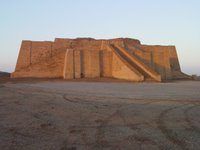


The Ziggurat was built around 2100 B.C. One thing that I found interesting was that the structure itself is solid. That is, it has no rooms or open areas inside. According to Muhsen, the Ziggurat was built by the Sumerians as a way in which to be closer go the god of the moon. The moon god was suppose to come from the sky and walk down the steps of the Ziggurat to be with the people. The Ziggurat itself was uncovered in the mid-1800's by the British. Apparently, there was at least one more level above the current Ziggurat structure that didn't survive the excavation.
Most of the structures at the city of Ur site are original. Muhsen said that the bricks in the public buildings (like the Ziggurat) are held together with a natural tar-like substance. Because the substance was so expensive back then, private buildings (such as dwellings) often used instead a mud-based substance to hold the bricks together. Here’s a picture of Muhsen explaining some of the details about how the buildings were made:
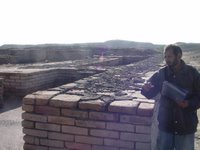
Below are several things “of note” at the site that I thought were fascinating:
*The site had many examples of ancient cuneiform writing, which according to Muhsen predates hieroglyphics. Here’s a sample:

*Small sea shells from one of the two floods (estimated to have occurred around 4000 B.C. and 2900 B.C.) were all over the place. It was strange to see small sea shells not on the sea shore but on the desert floor instead. :-)
*There were several tombs of kings in which 50 or so servants were buried alive (apparently voluntarily). Here are a number of pictures.

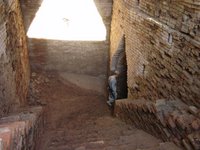
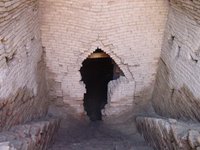

Compare those pictures of tombs with a picture of a tomb of a “common” person, not much higher than mid-thigh:

*The world’s first arch according Muhsen (or perhaps oldest intact?) is located on the site. Here’s a picture:

*There was also a structure the Muhsen said was the first museum. It was a structure that housed a collection of items from earlier times that was put on display for others to see. Here’s a picture of that building:

(the cement on top was put there in the 1990s to preserve the structure in anticipation of a visit from the Pope).
*Finally, we looked at the house of Abraham. The house itself was rebuilt. When they dug up the ruins, all that was left from the site was the foundation and the floors. So, they rebuild the ground floor walls. Apparently, Abraham was fairly well off primarily because of his father’s success as a businessman. According to Muhsen, Abraham’s father earned money by selling idols. That’s ironic. Anyway, Abraham’s house was fairly large. It consisted of more than one level, which wasn’t common for a dwelling back then in that area. The pictures below are of the dwelling, including one with soldiers walking on the walls that formed the basis for the second floor.
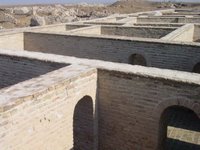

Back in the day, the Euphrates River flowed near the city walls of Ur. According to Muhsen, the city reached a population of somewhere between 250,000 and 500,000. By around 400 B.C. though, the city was deserted. It is thought that the reason for this was the shifting of the Euphrates River. Prior to the shifting of the river, there apparently was grass, trees and a significant amount of vegetation. My, how times have changed.
The most visible dwelling in the area is the Ziggurat. It stands about 70 feet tall. Here are pictures of the Ziggurat from afar and one with me running up its steps:



The Ziggurat was built around 2100 B.C. One thing that I found interesting was that the structure itself is solid. That is, it has no rooms or open areas inside. According to Muhsen, the Ziggurat was built by the Sumerians as a way in which to be closer go the god of the moon. The moon god was suppose to come from the sky and walk down the steps of the Ziggurat to be with the people. The Ziggurat itself was uncovered in the mid-1800's by the British. Apparently, there was at least one more level above the current Ziggurat structure that didn't survive the excavation.
Most of the structures at the city of Ur site are original. Muhsen said that the bricks in the public buildings (like the Ziggurat) are held together with a natural tar-like substance. Because the substance was so expensive back then, private buildings (such as dwellings) often used instead a mud-based substance to hold the bricks together. Here’s a picture of Muhsen explaining some of the details about how the buildings were made:

Below are several things “of note” at the site that I thought were fascinating:
*The site had many examples of ancient cuneiform writing, which according to Muhsen predates hieroglyphics. Here’s a sample:

*Small sea shells from one of the two floods (estimated to have occurred around 4000 B.C. and 2900 B.C.) were all over the place. It was strange to see small sea shells not on the sea shore but on the desert floor instead. :-)
*There were several tombs of kings in which 50 or so servants were buried alive (apparently voluntarily). Here are a number of pictures.




Compare those pictures of tombs with a picture of a tomb of a “common” person, not much higher than mid-thigh:

*The world’s first arch according Muhsen (or perhaps oldest intact?) is located on the site. Here’s a picture:

*There was also a structure the Muhsen said was the first museum. It was a structure that housed a collection of items from earlier times that was put on display for others to see. Here’s a picture of that building:

(the cement on top was put there in the 1990s to preserve the structure in anticipation of a visit from the Pope).
*Finally, we looked at the house of Abraham. The house itself was rebuilt. When they dug up the ruins, all that was left from the site was the foundation and the floors. So, they rebuild the ground floor walls. Apparently, Abraham was fairly well off primarily because of his father’s success as a businessman. According to Muhsen, Abraham’s father earned money by selling idols. That’s ironic. Anyway, Abraham’s house was fairly large. It consisted of more than one level, which wasn’t common for a dwelling back then in that area. The pictures below are of the dwelling, including one with soldiers walking on the walls that formed the basis for the second floor.


Back in the day, the Euphrates River flowed near the city walls of Ur. According to Muhsen, the city reached a population of somewhere between 250,000 and 500,000. By around 400 B.C. though, the city was deserted. It is thought that the reason for this was the shifting of the Euphrates River. Prior to the shifting of the river, there apparently was grass, trees and a significant amount of vegetation. My, how times have changed.